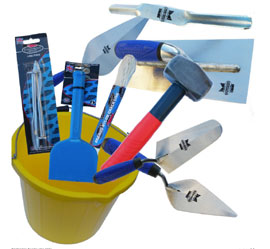
Working on your concrete wall plastering requires you to be aware of the tools. You're going to be working with them so you've got to understand what are their functions and how they can help make you work faster.
This tools will provide you help and can help you expedite your task. It is essential to realize what are their intention and it is equally important to know them.If you are looking to do plast ering courses this will enable you to achieved this.
Listed below are one of the most common tools for plastering:
• Lime: They work similar to gypsum however requires floated following the application of brown coat.
• Plastering Machine: It's got two kinds; dry mix machine which carries every one of the dry materials where water mixes with all the mix as well as the pressure offers the spraying force; as well as the wet mix machine which already carries the mixed plaster. Wet type of machine is easily the most popular.
• Portland cement: Is a cement mortar that's usually applied 3 times. The recommended thickness is 3/8” both for brown and scratch coat, while, the finish coat should be about 1/8”. Fog-spray should be applied for 48 hours on both scratch and brown coat. The finishing needs to be applied Few days following application of brown coat.
• Feather and Straight Edges: The feather edge has blade tapers employed to sharpen the sides. Also, it is utilized for cutting the corners within, shaping it into razor-sharp edge and producing straight lines that will aid being a guide in which the outside walls intersect. While, straight edge can be used to level the applied plaster. It's produced from wood or metal blade that includes a handle.
• Portland cement: Is a cement mortar that is usually applied 3 times. The recommended thickness is 3/8” for brown and scratch coat, while, the completed coat should be about 1/8”. Fog-spray should be applied for 48 hours on both scratch and brown coat. The finishing need to be applied Full week right after the application of brown coat.
• Scarifier: It is designed to improve the surface and to make sure that the wall holds the plaster.
• Scarifier: It is utilized to enhance the surface and to be sure that the wall will hold the plaster.
• Plastering Machine: It has two types; dry mix machine which carries all of the dry materials where water fuses with the mix and the pressure provides the spraying force; and also the wet mix machine which already carries the mixed plaster. Wet type of machine is the most commonly used.
• Trowels: The most important plastering tools may be the trowels are it is utilised in applying, spreading and smoothing the plastered surface. It has four types such as rectangular trowel for conveying and manipulating the plaster, pointing trowel incase the rectangular can not be used, margin or even a squared trowel and angle trowel for corners.
Those are the plastering tools that you need to be familiar with before starting the plastering work. Knowing their purposes and advantages will let you work faster and you will come up with a good output.Lastly, do not forget to clean your tools after you finish using them as this will prolong its life.